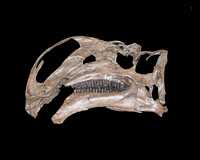 |
|
LOCALITY:
Khuren Dukh, Gobi Desert, Central Mongolia
AGE:
Early Cretaceous (Aptian), Barun Bayan Formation, 110
million years ago
SIZE:
Up to 9 m long
MEANING OF NAME:
'Iguana tooth'
PRONUNCIATION:
Eh-GUAN-o-don
CLASSIFICATION:
ORNITHOPODA: Iguanodontia; Iguanodontidae
The least modified descendants of the
fabrosaurid/hypsilophodontids are the iguanodontid
dinosaurs. Basically, they differ primarily from their
ancestors simply by their larger size and changed
proportions. The iguanodontids take their family name
from Iguanodon which was one of the first
dinosaurs described (in 1825) and scientifically named as
well as one of the first to be known from an entire
skeleton. First recognised in Europe, it is now known
from North America as well as Asia.Iguanodon stood on two
hind legs, with three toes on each foot. Its hands had
four fingers and a spike-like thumb, which it may have
used to defend itself. Its teeth are reminiscent of those
in hypsilophodonts, flattened side to side, and
leaf-shaped. They probably sliced up plant material like
a pair of scissors. Iguanodon orientalis from
Mongolia is very similar to iguanodonts from Europe
except for its huge, bulbous 'nose.' This hollow
structure may have been used as a resonating chamber for
making 'dinosaur music! 'Because of the large number of
skeletons of these dinosaurs frequently found together
and evidence from fossil track ways, palaeontologists
think they may have formed herds. Their remains are most
often found in sediments deposited in swampy, lake and
river edge environments suggesting that is the place they
spent most of their time munching on horsetails (like the
living Equisetum), ferns, cycads and various kinds
of conifers.
|
|
